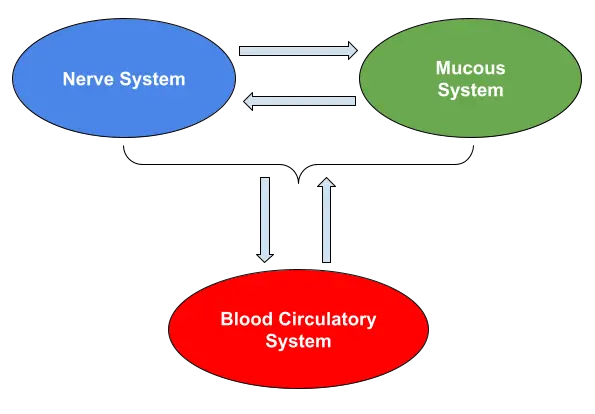Introduction to Ayurveda’s Body Systems
Ayurveda, an ancient Eastern philosophy, offers profound insights into maintaining health through a unique understanding of the body’s systems. Central to Ayurvedic theory are three critical bodily systems: the Mucous or Nutritive system, the Nerve system, and the Blood circulatory system. The intricate interplay and balance among these systems form the cornerstone of Ayurvedic health principles. However, improper diet and lifestyle can disrupt this symphony, leading to a cascade of health issues. Let’s uncover the profound insights of Ayurveda, unveiling the profound relationship between our body’s systems and the foods we consume.
The Three Major Systems of the Body
Ayurveda, an ancient medical system, recognizes three key systems within the human body critical for its functioning: the Mucous System, Nervous System, and Blood Circulatory System.
Mucous System (or Nutritive System)
The Mucous system, also known as the nutritive system, is responsible for absorbing nutrients from the food we consume and transporting them to various parts of the body. It comprises the gastrointestinal tract, including the stomach and intestines, as well as associated glands and membranes. The mucous lining of these organs protects them from damage and aids in the digestion and absorption of nutrients.
Nerve or Nervous System
The Nerve system is a complex network of nerves and cells that transmit signals between different parts of the body. It is divided into two main components: the central nervous system (CNS), which includes the brain and spinal cord, and the peripheral nervous system (PNS), consisting of nerves that extend throughout the body. The Nerve system plays a crucial role in controlling bodily functions, including movement, sensation, thought processes, and involuntary actions such as heartbeat and breathing.
Blood Circulatory System
The Blood circulatory system is responsible for circulating blood, oxygen, and nutrients throughout the body and removing waste products. It consists of the heart, blood vessels (arteries, veins, and capillaries), and blood. The heart pumps oxygen-rich blood from the lungs to the rest of the body via arteries, while veins carry oxygen-depleted blood back to the heart. Capillaries, the smallest blood vessels, facilitate the exchange of gases, nutrients, and waste products between the blood and body tissues. The blood circulatory system plays a vital role in maintaining balance and supporting the functions of other organ systems.
The Interrelationship Among the Three Body Systems
In a normal working state, the mucous system and the nerve system keep each other in check. Similarly, these two systems work together to manage the blood circulatory system, and at the same time, the blood circulatory system regulates them both. This interaction shows how the body maintains a natural balance. Having all three systems in balance is very important for good health. To explain it simply: (1) The nerve system controls the mucous system or nutritive system. (2) The mucous system controls the nerve system. (3) The nerve and mucous system together control the blood circulatory system. (4) The blood circulatory system controls the nerve and mucous system.

The Impact of Food on Body Systems
When the balance between the Mucous system, Nerve system, and Blood circulatory system changes, the body functions abnormally. Unbalanced conditions make their morbid appearance. In general, they are the result of improper diet. For instance, sweet, salty, and sour foods control the mucous system. In another sense, an excess amount of sweet, sour, and salty foods overstimulates the mucous system. It becomes out of control and many problems occur, such as obesity, diabetes, cough, asthma, loss of appetite, artery defects, gland defects, abnormal growth, voice defects, impotence, and blockage from excess mucous secretion.
Similarly, an excess of bitter, pungent, and astringent foods causes a loss in the Nerve system. These result in neurasthenia, arthritis, neuralgia, paralysis, joint pain, and other nerve defects.
Sour, salty, and pungent foods in excess, cause a loss of control of the blood circulatory system by the nerve and mucous systems, resulting in fever, inflammation, hepatitis, anemia, biliary defects, and weakness.
An excess of sweet, bitter, and astringent food causes loss of control of the nerve and mucous systems through the blood circulatory system, and results in various nerve and mucous disorders.
When sweet foods are consumed in excessive amounts, they apply a constrictory effect on the capillaries. Similarly, bitter and astringent foods also induce constriction. Conversely, sour and salty foods have a dilatory effect on the capillaries. Additionally, pungent foods have a dilatory effect but may also contribute to dryness.
Proper Combination of Six Tastes in Diet
In the Ayurvedic approach to health, the proper balance of six fundamental tastes in one’s diet – sweet, sour, salty, bitter, pungent, and astringent – is crucial for maintaining harmony within the body. This ancient Eastern science of life posits that each taste category corresponds to essential elements and plays a unique role in balancing the body’s three primary systems. By integrating a variety of foods from each taste group, one can align with the Ayurvedic principles that emphasize the interconnectedness of food and bodily well-being. This holistic dietary approach not only caters to the palate but also ensures the nourishment and equilibrium of the body’s fundamental components, fostering overall health and vitality.
| 90% | Sweet foods: Rice, wheat, barley, millet, corn, oats; Beans; Meat products; Vegetables; Fruits, etc. |
| 5% | Astringent foods: Beans; fruits; vegetables, etc. |
| 3% | Sour foods: Citrus fruits; etc. |
| 0.25% | Salt |
| 0.25% | Pungent spices: Ginger, black pepper, chili, etc. |
| 1% | Bitter foods: Turmeric, fenugreek, cumin seed, etc. |
Formula of Taste and Body Systems
The concept of taste and its impact on the body systems is a fascinating aspect of holistic health. In this context, specific tastes are believed to have a direct influence on the maintenance and control of different body systems. For the Nerve system, the tastes that play a pivotal role are sweet, sour, and salty. These flavors are not just sensory experiences but are understood to have a regulatory effect on the Nerve system, ensuring its proper functioning and balance.
Similarly, the Mucous system, which is crucial for nutrient absorption and protection of internal organs, is predominantly influenced by bitter, pungent, and astringent tastes. These tastes are thought to contribute to the overall health and efficiency of the Mucous system. Their presence in the diet is seen as vital for maintaining the system’s integrity and functionality.
Lastly, the Blood circulatory system, essential for transporting nutrients and oxygen throughout the body, is said to be controlled and maintained by a combination of sweet, bitter, and astringent tastes. These particular flavors are believed to support the circulatory system’s health, aiding in the effective circulation of blood and thus ensuring the vitality and well-being of the entire body. This concept underscores the significance of diet and taste in maintaining the health and harmony of our body systems.
In summary,
- Sweet, sour, and salty tastes control and maintain the Nerve system.
- Bitter, pungent, and astringent tastes control and maintain the Mucous system.
- Sweet, bitter, and astringent tastes control and maintain the Blood circulatory system.
General Pattern of Non-Vegetarian Meal
The general pattern of a non-vegetarian meal typically includes a balanced composition of various food groups.
| 3 parts | Starchy food prepared in any hygienic manner |
| 1 part | Meat, egg, or milk products including butter, ghee, cheese or yogurt (curd) |
| 1 part | Green vegetables and or seasonal fruits |
| 1 part | Liquid drink: water, tea, juice, etc. |
General Pattern of Vegetarian Meal
The general pattern of a vegetarian meal typically includes a balanced composition of various food groups.
| 4 parts | Starchy food prepared in any hygienic manner |
| 1 part | Beans: lentils, sweet peas, chickpeas, etc prepared in soup form. |
| 1 part | Milk products: milk, cheese, butter, yogurt, etc. |
| 1 part | Green vegetables and seasonal fruits |
| 1 part | Liquid drink: water, tea, juice, etc. |
Conclusion
In conclusion, Ayurveda, the ancient Eastern science, emphasizes the intricate interrelationship and balance between the body’s three major systems: the mucous (or nutritive) system, the nerve system, and the blood circulatory system. These systems are in a dynamic state of balance, influencing and being influenced by each other. The mucous and nerve systems, when functioning normally, regulate each other, and collectively, they govern the blood circulatory system, which in turn has a controlling effect on them. This balance is deeply impacted by diet, specifically the six tastes: sweet, sour, salty, bitter, pungent, and astringent. Each taste interacts with the body’s systems and elements differently, affecting their function. For example, an excess of certain tastes can lead to various health issues, such as obesity, diabetes, and nerve disorders, while a balanced intake promotes harmony within the systems. Ayurveda provides guidelines for the proper combination of these tastes in both vegetarian and non-vegetarian meals, ensuring that the body’s elements and systems are maintained in equilibrium, which is essential for overall health and well-being.
Author
Dr. Mana Bajra Bajracharya
PIYUSHABARSHI AUSHADHALAYA
Mahabouddha, Kathmandu, Nepal
For any inquiries or questions, please contact us
Copyright © AyurvedicClinic.Net. All rights reserved. Republishing and copying without authorization is prohibited.

